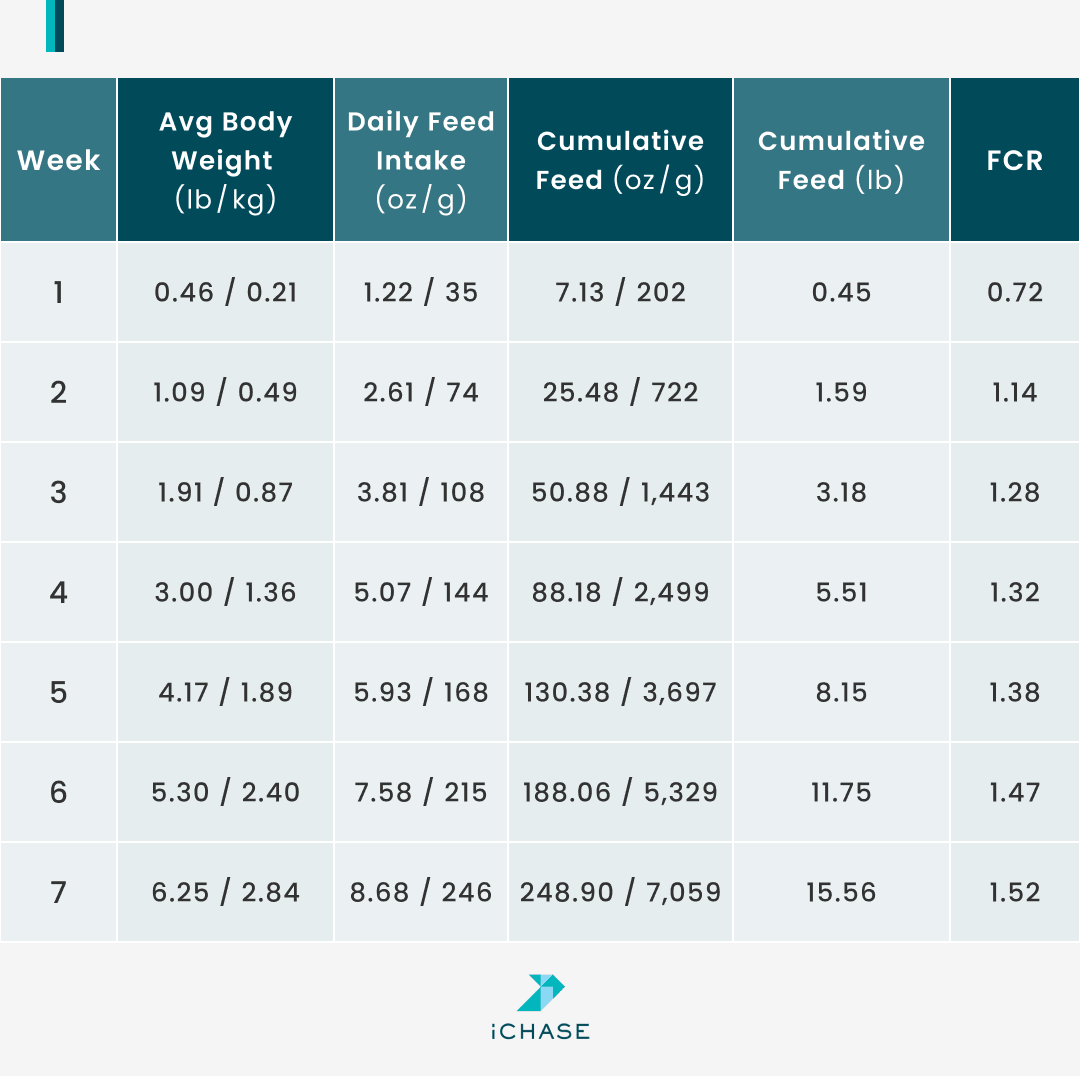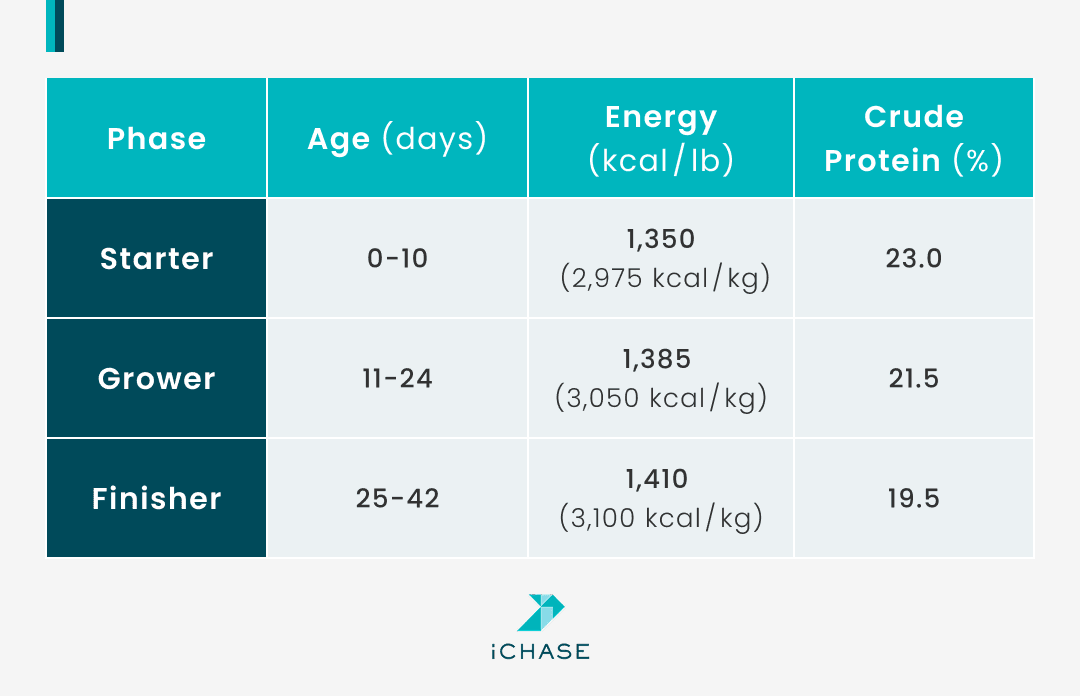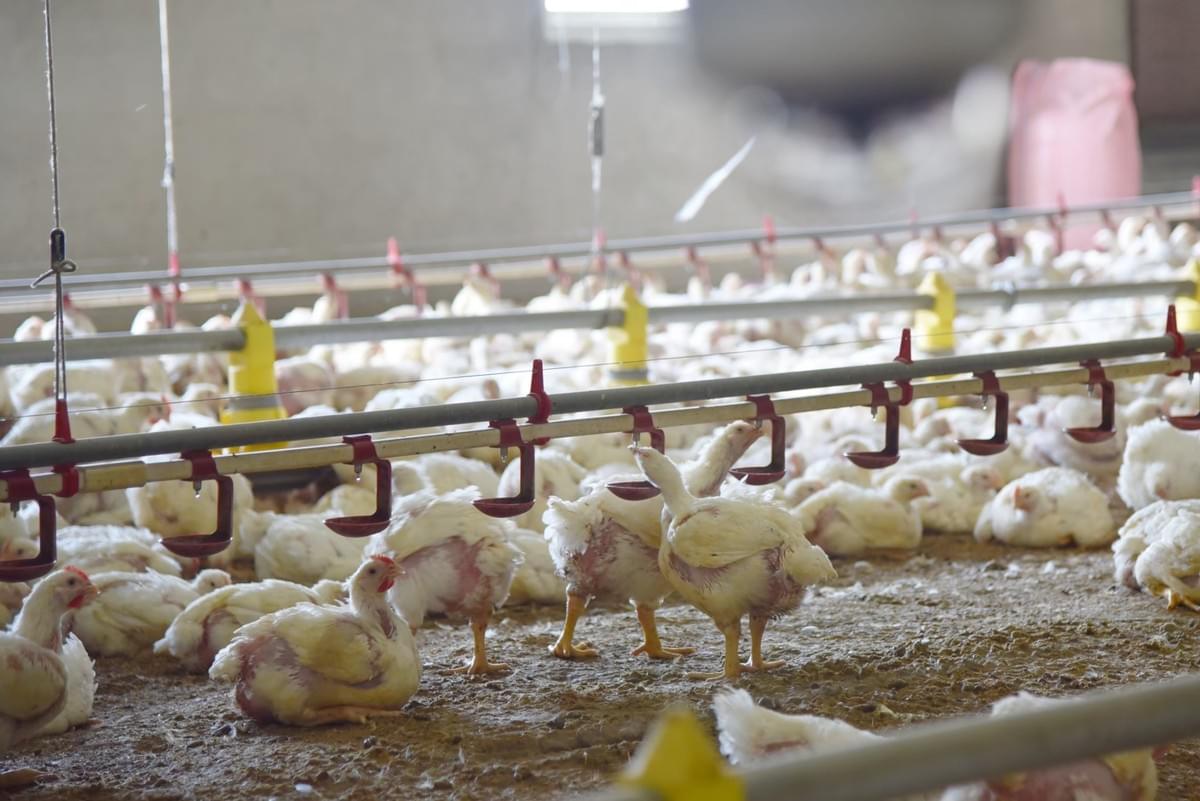
Weighing broiler chicks regularly is one of the most important steps in successful poultry farming. By keeping a broiler chicken growth rate chart, you can clearly track their weight gain and performance over time. This practice helps you know when to adjust nutrition, detect growth problems early, and make sure your flock is on the right path toward reaching the average broiler chicken weight on schedule.
In this article, we will use the Cornish Cross weight chart to illustrate how broiler chickens grow, from day one through the first month and beyond, and also explain what you should expect at different stages. Let’s go!
Broiler Chicken Weight Chart Per Day
The table below provides a typical growth schedule for a broiler chicken during its first 30 days. This period is critical, as the birds experience their most rapid growth and are highly efficient at converting feed into body mass. Farmers can use the chart to monitor performance at certain checkpoints:
- End of Week 1 (Day 7): Chicks should reach about 0.46 lb (0.21 kg). This early check shows whether brooding temperature, lighting, and feed access are working well. If weights fall short, review temperature stability and feeder space immediately.
- End of Week 2 (Day 14): Birds should weigh close to 1.09 lb (0.49 kg). A slower gain at this point may point to feed quality, water intake, or crowding issues. Adjust early before growth gaps widen.
- End of Week 3 (Day 21): Expected body weight is around 2.23 lb (1.01 kg). Feed consumption rises rapidly now, so maintaining clean feeders and steady ventilation helps keep feed conversion efficient.
- End of Week 4 (Day 28): Birds should reach about 3.77 lb (1.71 kg). This is a key checkpoint for early FCR evaluation. Farmers can assess if growth is tracking profitably before the finishing phase.

Broiler Chicken Weight Chart: After One Month
Now, let’s look at the weight on a weekly basis. After the initial rapid growth phase, the broiler's development continues at a steady pace. This is when the bird is nearing its market weight, which for most commercial operations is between 6 to 7 weeks.

Data Reference: Aviagen
Why FCR Matters
The data above also shows the calculation of Feed Conversion Ratios (FCR), which is the total pounds of feed consumed divided by the body weight gained. A lower FCR means the birds need less feed to gain weight, directly lowering feed costs. A higher FCR shows reduced efficiency, since more feed is required for the same growth, which drives up production expenses. Because feed represents the largest cost in broiler production, farmers and integrators closely track FCR as a key measure of profitability.
Looking at the trend, efficiency is highest during the early growth phase. In the first few weeks, FCR is low, showing very efficient feed use. By Weeks 5 and 6, it rises significantly as growth begins to slow and birds need more feed. By Week 7, the FCR reaches about 1.5, meaning each additional pound of gain comes at a higher feed cost.
The goal should be to aim for the lowest FCR possible at each stage, because that means your birds are converting feed into body weight efficiently. Lower FCR values improve profitability, while higher ones reduce it. The typical range provided here is for reference, as actual results can vary depending on different factors.
How to Feed Broiler Chicken: Best Practices
Feeding broilers isn’t just about filling up the feeders. It’s about getting the timing, balance, and consistency right. In the following sections, we’ll go over what truly matters: how to plan a proper diet, keep water clean and available at all times, and create the right feeding setup for steady growth. With these practices in place, you’ll raise healthier birds and run a more efficient broiler operation.
Feeding by Growth Phase
A well-planned broiler chicken feeding schedule helps your flock reach market weight efficiently while keeping them healthy and uniform. The following chicken feeding guide example uses the Aviagen Arbor Acres Broiler Nutrition Specifications (2022), designed for birds raised to around 4.4 lb (2.0 kg) market weight.
- Starter Phase (Day 1–10): In the first 10 days, chicks grow rapidly and need a nutrient-dense diet. Use a starter feed containing about 23% crude protein and 1,350 kcal/lb (2,975 kcal/kg) of metabolizable energy. This high-protein feed builds muscle, supports organ growth, and strengthens immunity. Early feeding, right after hatching, encourages healthy gut development and better lifetime performance.
- Grower Phase (Day 11–24): As birds enter the grower phase, they shift from rapid tissue development to muscle expansion. Provide a grower feed with about 21.5% crude protein and 1,385 kcal/lb (3,050 kcal/kg) of metabolizable energy. This balance supports strong muscle growth and efficient feed conversion.
- Finisher Phase (Day 25–42): The last phase focuses on efficient weight gain and carcass quality. Feed a finisher diet with about 19.5% crude protein and 1,410 kcal/lb (3,100 kcal/kg) of metabolizable energy. Energy density rises slightly to support maximum growth, while protein levels taper down as birds deposit more fat and less lean tissue. A good finisher promotes desirable body weight, clean fat cover, and a firm meat texture.

Feeder Setup

Efficient feeder design is essential for healthy, productive chicks. For day-olds, provide chick trays or khaki paper at a rate of one per 50 chicks. Use round or tube feeders (1 per 50–60 birds) or pan feeders (1 per 50 birds); pan feeders are especially effective because they reduce spillage, ensure smooth feed flow, and allow comfortable access.
Always adjust feeder height to align with the birds’ backs. Too low leads to wasted feed, while too high discourages smaller birds from eating. As your flock matures, raise the feeder lip so it stays level with the back height. This keeps intake steady and reduces losses.
Nutrition Fine-tuning
Fine-tuning feed composition often makes the biggest difference in growth. Amino acids like lysine and methionine are key drivers of muscle development, and their balance matters. For example, research suggests keeping the isoleucine-to-lysine ratio at about 65% for good results in lower-protein diets.
Enzymes also improve feed efficiency. Phytase boosts nutrient absorption, lowering feed cost, while enzymes like xylanase or β-glucanase help break down specific grains for better digestion. Many farms today are also adopting all-plant protein programs, which reduce gut stress and help keep litter drier when properly formulated.
Water Quality
Providing water at all times is essential for healthy broilers, as birds typically consume 2–3 pounds of water per pound of feed. Also, water intake drives feed intake, so quality and access are non-negotiable. Always provide clean water, tested for pH, minerals, and microbes. For best performance:
- pH: 5.5–6.5
- Iron: below 0.2 ppm
- Coliforms: non-detectable
Flush water lines often and disinfect between flocks to keep systems clean. Check height weekly. Too low causes spills, while too high makes drinking difficult. Remember, if water quality or flow is poor, feed consumption drops right away.
Moreover, appropriate equipment includes chick fonts (1 per 50–75 chicks), 16-liter drinkers (1 per 50–60 birds), automatic bell drinkers (1 per 75–100 birds), or nipple drinkers (1 per 12 birds). Always adjust the drinker height to align with the birds’ backs. Too low or too high can reduce intake.
Why are My Broilers Underweight?
Sometimes, despite your best efforts, broilers just don’t put on the weight you expect.
One of the biggest culprits is disease. Problems like coccidiosis, chronic respiratory infections, or worms can rob your birds of nutrients and slow down growth. For example, coccidiosis damages the gut lining, so even if your chickens eat well, they can’t absorb nutrients properly. The solution here is early detection and quick treatment. Keep an eye out for unusual droppings, droopiness, or reduced appetite, and consult a vet right away.
Environmental stress is another big factor. Broilers are very sensitive to their surroundings. If the coop gets too hot, the birds eat less, pant, and end up losing weight instead of gaining. On the flip side, if it’s too cold, they burn extra energy just to stay warm. Both situations waste feed and lower growth performance. That’s why it’s so important to maintain steady, comfortable temperatures, ensure proper ventilation, and keep litter dry.
Feed issues are also common. Broilers grow fast, but only if the feed is fresh, balanced, and appealing. Dusty or poorly mixed feed means some birds won’t get enough protein or energy to hit their growth targets. To address this, always buy quality feed, store it properly to avoid mold, and mix supplements thoroughly if you use them.
Let’s not forget parasites. Internal worms steal nutrients, while external pests stress your birds, both leading to poor feed conversion. Regular parasite control, whether through preventive treatments or scheduled checks, is key to keeping growth on track.In short, most underweight problems come down to management. Want to dive deeper? Check out our full guide on broiler management to learn how to run your broiler farm more effectively.
How to Record the Broiler Growth Chart: Common Methods
There are two main ways farmers record broiler growth: manual sampling and automatic weighing systems.
Manual sampling is the traditional approach, where a small group of birds is caught, weighed by hand, and then compared to the breed’s growth chart. While this gives a general idea of progress, it only provides data every few days, requires significant labor, and can cause stress for the chickens during handling.
Automatic weighing systems, on the other hand, use smart sensors and digital scales placed directly inside the poultry house to track weights continuously. These systems can provide updates every hour, giving farmers real-time insight into how the flock is performing. This makes management much easier, as the process saves labor, reduces stress on the birds, and provides far more accurate results.
The benefits of automation go even further. Because sick birds often lose weight before showing visible symptoms, farmers can detect early signs of disease sooner. In larger poultry sheds, weight readings from different sections can reveal uneven growth. This allows farmers to fine-tune ventilation, temperature, or feed distribution, helping the flock grow more evenly. Frequent sampling is important for managing broiler health, but automation makes it possible without putting unnecessary pressure on the birds.
Benefits of Having Precise Weight for Broilers
Accurate weight tracking plays a direct role in both profitability and animal welfare. By keeping weights within the profitable range, farmers can improve their out-of-window rate and reduce the risk of being fined by slaughterhouses when birds fall outside target weights.
Precision monitoring also makes it possible to connect weight data with feed and water intake, giving farmers a clearer picture of flock health. This means problems such as growth delays or illness can be identified earlier, reducing costly mistakes.
In the end, precise weight monitoring not only helps farmers cut waste and save feed costs, but it also supports healthier, more uniform flocks. For growers and integrators alike, reliable weight data is one of the most powerful tools for maximizing efficiency and protecting profits.
iCHASE Offers You the Smart Broiler Chicken Weighing Scale System

Raising broilers is a race against time, and every ounce matters. The growth charts give you the roadmap, but staying on track means knowing exactly where your flock stands each day. Imagine if instead of chasing birds with a scale, you could glance at real-time data and see whether they’re gaining the right weight, hitting the targets, or showing signs of trouble.
So why wrestle with clipboards and random samples when you can have 24/7 flock insight? With InsightScale, your broilers’ progress isn’t just tracked, it’s predicted, giving you the confidence to grow healthier, heavier birds and boost your bottom line. Contact us today to know more about our innovative weighing solutions!
